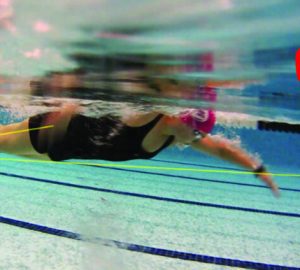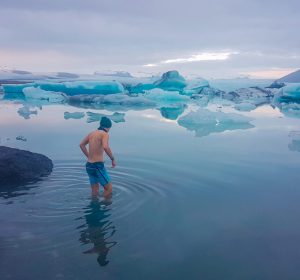
Swimming as ‘Moving Meditation’
In 2006 I swam in the 3K open water event of the FINA Masters World Championship. Held in San Francisco Bay, it was the most interesting event I’d ever swum, because it exposed the field of several hundred swimmers to three distinct sections, each presenting different challenges and opportunities.
We were sent off in waves five minutes apart. I was in the seventh wave – men in their 50s. In the first kilometre, we swam across a calm, sheltered bay. The main choice presented was how far to dolphin off the bottom before beginning to swim, as the course was quite shallow for the first 50 metres. My own approach was informed by watching earlier heats to observe how the lead swimmers handled this.
In the middle section, we entered a narrow channel, 800-metres long, lined with boats tethered to the walls. I’d swum the course a day earlier to familiarise myself and had made a plan to navigate by breathing bilaterally, keeping the channel walls equidistant. This minimised the need to lift my head and look forward.
As we approached the outlet of the channel into the main body of San Francisco Bay, there was a car-tyre breakwater. Still breathing bilaterally and looking forward only infrequently, I could feel large swells. This alerted me that we’d encounter strong winds and rough seas beyond the breakwater.
From my reconnaissance swim the day before, I knew the first part of this section followed the curve of the island for approximately 200 metres before striking out across the bay straight to the finish. After passing the breakwater, I took one look forward and could see only a wall of green water. I decided to navigate this curving section of the course by breathing only to the left, keeping the shore at a constant distance.
Total Immersion coach Shinji Takeuchi was positioned at the breakwater with a video camera. He picked me out as I passed the breakwater and walked the shoreline for several minutes, tracking me and a dozen or so swimmers. What I saw when I viewed the video later was striking.
Everyone around me flailed their arms and whipped their heads around in response to the rough water. Many looked forward virtually every stroke. Their forward peeks provided no useful information, yet they kept doing it time after time. In contrast, I stroked with control and breathed repeatedly to my left, smoothly navigating through the pack without ever looking forward.
This video provides an example of mindfulness v mindlessness in challenging conditions. Swimmers who picked up their heads weren’t acting rationally, as they never changed their tactic despite seeing nothing of value. Overcome by their circumstances they reacted by reflex.
This leads to a definition of mindfulness: the ability to control and direct your thinking, transforming your thoughts from a distraction to a powerful tool, particularly in a demanding or stressful situation, such as we commonly face in open water. In each section of that race, I faced conditions that offered opportunity or challenge. Being mindful allowed me to calmly assess each situation and respond with a strategy to optimise an opportunity, or minimise a challenge. It also helped me win a World Championship medal.
The great majority of participants in any open water event practise mainly in pools, where conditions are predictable and little-changing. Our challenge – or opportunity – is to use pool training to lay a foundation for the ability to be observant and opportunistic in the unpredictable conditions we face in open water.
Though I didn’t practise formal meditation until recently, I discovered mindfulness through swimming – though it wouldn’t have occurred to me to call it that at the time. From 1964 to 1988, I swam much as other competitive swimmers did, focussing mainly on ‘getting in the yardage.’ But in 1988 an innovative coach named Bill Boomer taught me a balance drill that lifted my formerly-heavy hips and legs to the surface.
It was such a novel and welcome sensation that I wanted to make it permanent. This required me to focus on aligning my head and spine and to extend my hand at a slight downward angle. As those thoughts were completely new, I had an inkling that I’d return to old habits if I didn’t focus on these new sensations on every lap.
I thought of them, and almost nothing else, for six months before it felt ‘safe’ to turn my attention to another thought without losing the still-fragile sensation of ‘weightlessness.’ That new thought was to use my arm to lengthen my bodyline, more than push back, and keep it long between strokes. That became another six-month project.
It also set me on a path I remain on to this day:
•
Start every practice (pool and open water) with an intention to improve my swimming, and a plan to produce that result.
•
Start every length, repeat and set with a mental blueprint of a mini-skill I will try to perform better than I ever have in my life.
•
Take every stroke with keen awareness: what sensation will tell me I’m accomplishing my skill goal?
In the summer of 1989, nine months after my life-changing balance lesson with Bill Boomer, I held the first Total Immersion camp, and began teaching my new way of practising to others. I did so fully aware that acquiring the ability to maintain focus on a single thought would be even more challenging than, say, aligning the head and spine. New habits are difficult to form; old habits even harder to break.
We swimmers face a unique challenge to mindfulness: everything in swimming’s ‘training culture’ encourages autopilot – rather than mindful – thinking. Follow the black line… Get to the other end… Long sets of rote repetition that we just get through… The ‘hamster on a wheel’ (chased by several other hamsters) feeling of group training.
That told me we had to emphasise to our students that mindfulness – the ability to stay focused on one chosen thought – would be the fundamental skill of change, improvement and growth. It would also be vulnerable to the mainly-physical emphasis of the environment to which they’d return.
But we soon received enthusiastic feedback from those to whom we’d taught this practice habit:
•
Being mindful played as large a role as newly pleasurable physical sensations in their becoming passionate about swimming.
•
Practice had become its own reward; they’d finish one practice looking forward to the next.
•
Applying mindfulness to swimming reminded them of other forms of practice: music, dance, aikido. It also helped relieve stresses encountered outside the pool.
Over the intervening 25 years, mindfulness has become a core value of Total Immersion, and our applications of it in TI learning and training methods have steadily become more robust. When we began organising open water ‘learning vacations’ 15 years ago, it was natural to make mindfulness a centrepiece.
At the beginning of each open water clinic or camp, we tell our students: pool swimming is predictable and controllable; open water is unpredictable and – sometimes – difficult to control. The most important thing we’ll teach you here is how to think when the unpredictable happens – as it almost certainly will.
Habits I began developing while trying to align head and spine in the pool converted easily and naturally into essential tools for adapting to the many things one encounters in open water that are impossible to prepare for in the pool: wide open and ill-defined spaces; pack swimming and physical contact; very great distances; conditions of all sorts from chop and swells to changing wind direction to bone-chilling temperatures.
And the moving meditation that has made pool practice its own reward, for me and countless others, has also enabled us to transform any open water swim – from a 3K race to an 18K swim across Gibraltar Strait – into an art form, or a kind of game.
Total Immersion
Terry Laughlin is founder and head coach of Total Immersion and winner of six national masters championships since turning 55.
The Total Immersion 2.0 Freestyle Mastery Self-Coaching Course teaches ‘Expert’ Pacing/Tempo Training and three other Mastery skills for freestyle.








